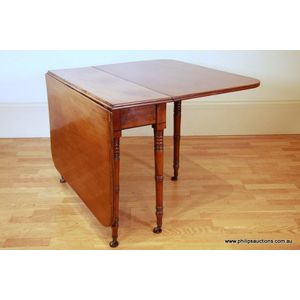French Art Deco Rosewood Chairs
You must be a subscriber, and be logged in to view price and dealer details.
Subscribe Now to view actual auction price for this item
When you subscribe, you have the option of setting the currency in which to display prices to $Au, $US, $NZ or Stg.
- Rosewood - A dense timber that varies in shade to very light brown to almost black. When rosewood is cut and sanded the colour of the timber will turn black, and after polishing and exposure to daylight, the surface will gradually lighten over time to light brown with black streaks.
The name comes from the odour emanating from the timber when it is planed, sanded or cut.
Rosewood was very popular for use in Victorian furniture in the second half of the 19th century, and at that time most of the rosewood was imported from Brazil. However it also grows in India and Indonesia.
It is used in the sold for chairs and table legs, but for carcase furniture such as side cabinets and bookcases, and for table tops it is always used as a veneer. - Stile - A cabinetmaker's term that refers to the vertical end members of the framework in a panelled item of furniture. The vertical mid-members are known as muntins.
- Art Deco Period - The Art Deco period was a cultural movement that emerged in the 1920s and 1930s, and was characterized by its emphasis on modernism, luxury, and elegance. The name "Art Deco" comes from the Exposition Internationale des Arts Décoratifs et Industriels Modernes, a large exhibition held in Paris in 1925 that showcased the latest trends in decorative arts.
Art Deco was a reaction against the ornate and elaborate styles of the previous era, and reflected a new modern sensibility. It was characterized by streamlined, geometric shapes, bright colours, and the use of new materials such as chrome, glass, and Bakelite. Art Deco designers sought to create a sense of luxury and sophistication, often incorporating expensive materials such as ivory, marble, and rare woods.
Art Deco had a significant impact on a wide range of artistic fields, including architecture, fashion, graphic design, and interior design. Some of the most iconic examples of Art Deco architecture include the Empire State Building in New York City, the Hoover Building in London, and the Palais de Chaillot in Paris.
The Art Deco period came to an end in the 1940s, as World War II and changing cultural trends led to a shift in artistic styles. However, Art Deco remains an important influence on design and art, and continues to be celebrated for its modernist sensibility and glamorous aesthetic.
This item has been included into following indexes:
-
chairs, sets of 6, style or period
- Art Deco style 10
- French 171
-
chairs, sets of 6, timber
- all styles and timbers 749
- rosewood 32
Visually similar items

A Georgian/early Victorian mahogany gateleg table, circa 1830s-40s, the table with long drop sides with reeded edges, raised on slender turned and tapering legs with petite brass casters. Height 69 cm. Extended length 147 cm. Width 90 cm

Empire mahogany side chair with applied brass rosette and scroll decoration to top, upholstered back and seat in green velvet

A 1960s Danish side drawer table, rosewood with single central drawer, 43 cm high, 62 cm wide, 42 cm deep

A French mahogany leather top two drawer writing desk on square tapering legs. 73 cm high, 98 cm wide, 49 cm deep.
